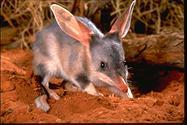Bilby
|
|
| Bilbies | ||||||||||||||
|---|---|---|---|---|---|---|---|---|---|---|---|---|---|---|
 Greater bilby | ||||||||||||||
| Scientific classification | ||||||||||||||
| ||||||||||||||
| Species | ||||||||||||||
|
M. lagotis |
Bilbies are marsupial omnivores; members of the bandicoot family. Before European colonisation of Australia there were two species. One became extinct in 1931, the other survives but remains endangered. The bilby is known as the dalgite in Western Australia and the pinkie in South Australia.
Bilbies have the characteristic long bandicoot muzzle and very long ears. As compared with other bandicoots, they have a longer tail, bigger ears, and softer, silky fur. They are nocturnal omnivores that do not need to drink water, as they get all the moisture they need from their food, which includes insects and their larvae, seeds, spiders, bulbs, fruit, fungi and very small animals. Most food is found by digging or scratching in the soil, and using their very long tongues.
They are excellent burrowers and build extensive tunnel systems with their strong forelimbs and well-developed claws. A bilby typically makes a number of burrows within its home range, up to about a dozen, and moves between them, using them for shelter both from predators and the heat of the day.
- The Bilby or Greater Bilby (Macrotis lagotis) is the largest of the bandicoots: at 1 to 2.4 kg the male is about the same size as a rabbit. The female is smaller, around 0.8 to 1.1 kg. The Bilby has an excellent sense of smell and sharp hearing. The fur is blue-grey with patches of tan and very soft. The tail is black and white with a distinct crest. The Bilby has strong forelimbs and thick claws, which it uses to dig for food and make burrows. Once widespread in arid, semi-arid and relatively fertile areas, the Greater Bilby is now restricted to arid wastelands and remains endangered.
- The Lesser Bilby or White-tailed Bilby (Macrotis leucrura) is extinct. It was grey-brown, fading to pale grey underneath with a white tail, and much smaller than the Greater Bilby at around 300 to 450 g. It is known only from the Gibson and Great Sandy deserts of arid central Australia; it may have had a greater range but this must remain unknown. It was exterminated by fur trapping, fox predation, and competition from rabbits. The last confirmed sighting was in 1931.
There have been reasonably successful moves to popularise the Bilby as a native alternative to the Easter Bunny by selling chocolate Easter Bilbies (sometimes with a portion of the profits going to Bilby protection and research). Reintroduction efforts have also begun, with a successful reintroduction into the Arid Recovery Reserve in South Australia in 2000Template:Ref, and plans underway for a reintroduction into Currawinya National Park in QueenslandTemplate:Ref.
| Contents [hide] |
References
Template:Note Moseby K. E. and O'Donnell E. O. (2003) Reintroduction of the greater bilby, Macrotis lagotis (Reid) (Marsupialia: Thylacomyidae), to northern South Australia: survival, ecology and notes on reintroduction protocols (http://www.publish.csiro.au/paper/WR02012.htm) Wildlife Research 30, 15-27. Template:Note Queensland Government (2004) Save The Bilby Appeal (http://www.epa.qld.gov.au/nature_conservation/wildlife/endangered_animals/bilby/save_the_bilby_appeal/)
See also
External Links
- Easter Bilby (http://www.easterbilby.com.au)
- Arid Recovery (http://www.aridrecovery.org.au)
- Currawinya National Park (http://www.epa.qld.gov.au/projects/park/index.cgi?parkid=79)
Pictures of Animals
- Classroom Clipart Pictures and Photos of Animals (http://classroomclipart.com/cgi-bin/kids/imageFolio.cgi?direct=Animals)
Animal Clipart
- Animal Clipart (http://classroomclipart.com/cgi-bin/kids/imageFolio.cgi?direct=Clipart/Animals)
